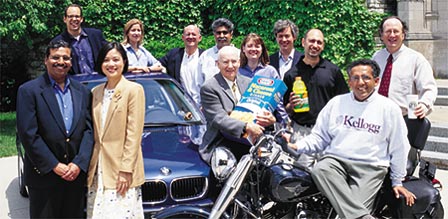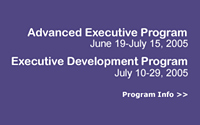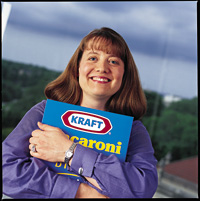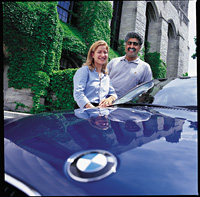 |
© Nathan Mandell |
Achieving
market leadership
A host of challenges face business leaders
today as they strive to create unique value for customers.
Winning the battle, say Kellogg School experts, takes a holistic
strategy that smashes functional silos and taps diverse resources.
By Matt Golosinski
| |


|
| |
|
Marketing
has been around for at least 5,000 years, with evidence of the
profession dating back to the Babylonians. Archeologists have
discovered the equivalent of ancient billboards in Rome advertising
rental property, and in Pompeii, a display hawking a good place
to drink in the suburbs.
The first advertisement in English appeared
in 1472: a handbill announcing a prayer book for sale. Two
centuries later, the first newspaper ad arrived. Since then,
with the expansion of business in the 19th century, and the
competitive markets of the digital age, products and services
have proliferated, and marketing along with them, until today
we find ourselves in a sea of sound and image that tries to
convince us to “reach out and touch someone,”
“think different,” or “fly the friendly
skies.”
Kellogg School faculty say marketing has grown
crucial in response to Internet-era competition. Today marketing
touches every aspect of an organization. Or it should.
“On one level, everything is marketing,”
says Marketing Professor Angela Lee. “You can only talk
about functions like finance or organizational behavior when
you have some product or service to offer. If I don’t
have that, why do I need an accountant?”
Silo
busters
No longer a functional “silo” — at least in
top organizations such as Starbucks, BMW, Southwest Airlines
and the Kellogg School, itself a brand leader in management
education — marketing is increasingly the hub through
which all organizational functions flow.
Call it “holistic marketing,”
as do Kellogg School marketing gurus Philip Kotler and Dean
Dipak Jain in their text Marketing
Moves: A New Approach to Profits, Growth and Renewal
(co-written with Suvit Maesincee). The authors explain how
successful firms link marketing to strategy, operations, accounting
and other areas to win in the information-based economy.
“Marketing has not kept pace with the
technologically sophisticated markets,” says Kotler,
the S.C. Johnson & Son Distinguished Professor of International
Marketing, who has written more than 20 influential marketing
texts over three decades (see Buy
the Book). Kotler insists that customers, not products,
are scarce today. Holistic marketing argues that firms will
only be leaders by embracing a customer-centric model that
rethinks corporate strategy, making marketing the lead driver
leveraging digital communications to deliver value.
At the heart of this mission, says Jain,
is innovation, something at which
Kellogg excels. “Kellogg embraces the culture of change.
Leadership, in marketing or any area, requires that you have
a clear vision, but with flexibility built into it,”
he explains.
Kellogg has remained an academic leader, in
part, by breaking down departmental silos to enable faculty
to communicate across disciplines, Jain says. This model is
one he believes also serves corporate leaders, since marketing
is about communications — both outside and inside the
firm.
Externally, marketers must connect with customers
to cultivate lasting relationships, primarily by solving problems
for these customers.
Internally, marketers and their peers have
to find common language with which to articulate their collective
efforts, or else risk being overtaken by more focused rivals.
 |
|
© Nathan Mandell
Marketing Professor Greg
Carpenter models a Nike running shoe. |
|
| |
|
Not just value, unique value
Gregory Carpenter, The James Farley / Booz•Allen Hamilton
Professor of Marketing Strategy, contends that marketing plays
this internal role by providing “a unifying theme for
people’s actions” which can lead to more integration
across functions.
“The more integrated you can be, the
faster you get to market, the higher the quality of your products,
the better the service,” says Carpenter, who cites Starbucks
and BMW as two paragons of marketing that understand the importance
of educating consumers about their products to create “unique
value.”
This accent on ensuring a firm’s internal
focus matches up with customer needs comes as the result of
decades-long shifts. The “make-and-sell” marketing
model prevalent before World War II gave rise to the “sales
approach” after the war. Today, even aggressive sales
strategies alone prove insufficient. Companies must now “sense-and-respond”
to customers’ needs, before customers even articulate
those needs.
“We’re used to saying that marketing
is about giving consumers what they want,” explains
Carpenter. “But as markets become more sophisticated,
you find consumers being overwhelmed with choices. One of
marketing’s important external roles is educating people
to understand and sift through the thousands of choices to
come up with something uniquely valuable.”
Kellogg itself serves as a case study, says
Carpenter, citing the “tremendous diversity of perspectives”
among the school’s faculty, as well as its theoretical
rigor dedicated to solving real-world challenges.
Jain says that this eclectic group of scholars
produces the cutting edge research and frameworks that differentiates
Kellogg from peers through “innovation and excellence.”
Innovation is part of what allows firms to
become “market makers,” as Professor Daniel Spulber
writes in Market
Makers, a strategic management text. He defines a
market maker as an organization that is not simply providing
better products and prices to consumers, but providing more
convenient service to customers and suppliers. Companies must
create new products, or devise a better way of bringing them
to market.
“Companies can no longer think of themselves
as just producers of products or suppliers of specialized
services,” says Spulber. These firms must understand
their roles as market creators, instead of viewing the market
as an external force beyond their control.
So how has marketing ended up in the center
of the corporate universe? The answer has something to do
with the Enron/Andersen debacle, global competition, and green
ketchup.
Hard
facts of intangible value
The
collapse of Enron and Arthur Andersen, when viewed superficially,
would seem only to serve as a primer on the Seven Deadly Sins.
Upon inspection, though, the situation also reveals a struggle
with issues of valuation that increasingly underpin the global
market. What the crisis in financial reporting shows, says Accounting
Professor Mark Finn, is that marketers, accountants and others
must work together to create a common framework that communicates
an organization’s tangible — and intangible —
value.
Today’s firms produce goods and services,
such as computer software, whose tangible value is minimal,
but whose intangible value — intellectual capital, say
— is enormous, and difficult to get down on traditional
balance sheets.
“What has happened over the last 30
years is that the market’s valuation of companies has
diverged and grown relative to the accountants’ valuation
of companies,” says Finn. “This cannot be written
off as irrational exuberance. It’s undeniable that the
traditional transactions-based accounting model is not capturing
all the intangible value locked up in these companies, a lot
of which is in the marketing operations, including the brand
value.”
Enron was only a recent example of a crisis
that Finn says has steadily grown over three decades as bricks
and mortar operations have declined in importance. Many firms
today, including traditional industrial companies, have come
to believe that the traditional accounting models failed to
capture the scope of their endeavors, leaving such things
as customer service and specialized expertise off the balance
sheets. So the firms have rewritten accounting rules to try
solving the dilemma. These tools, however, lacked any universal
standards.
Some companies outside the United States,
such as India’s Infosys, a software company that produces
a supplementary balance sheet alongside its traditional one
to capture assets such as brand and human capital, have begun
addressing the crisis. U.S. firms have yet to touch this approach,
which Finn notes is based on appraisals and market values,
frameworks more familiar to economies that have experienced
bouts with high inflation. “Accountants are afraid of
doing this,” Finn says. “It would involve a complete
transformation of the American accounting model.”
In fact, Finn sees the Enron situation as
having forced a retrenching within accounting that embraces
traditional transactions-based models.
“The problem is, the crisis itself originated from a
lack of confidence in this very model,” says Finn.
Finn’s recommendation, which he says
has lost support in the post-Enron era, is to build a model
where firms hire appraisers and marketing specialists to assess
the marketing-related intangibles and provide that information
in the financial statements.
Otherwise, the future of financial accounting
as an industry is in jeopardy, Finn believes.
 |
|
© Nathan Mandell
Accounting Information & Management Professor Beverly
Walther hugs a brand leader. |
|
| |
|
Speaking the same strategic language
While Finn’s analysis accentuates systemic corrections
involving marketing and accounting, the two disciplines interact
in other ways. Finn’s colleague, Accounting Professor
Beverly Walther, notes that these departments now often come
together earlier in the product development stages.
“Companies are revisiting their accounting
cost systems to ensure they get an accurate idea of how much
it costs to manufacture a product or provide a service,”
says Walther. “That’s critical information for
marketers.”
She notes that there is no one true product
cost for a diversified company, so accounting decisions made
when setting up the product costing system must incorporate
a myriad of determinations.
“These decisions can dramatically affect
the data you get out of the cost system,” Walther explains.
“When most people think of marketing, they think of
designing some sales promotion. They don’t think that
marketing can pervade all the communications taking place
between the firm and its constituents.”
Indeed, this is what Kellogg faculty say marketing
must do. Stephen Burnett, professor of strategic management
and faculty director for the Kellogg Executive Education Program,
has worked with executive clients to enhance their marketing
efficacy. He has written about his findings in the forthcoming
Kellogg on Integrated Marketing.
“Marketers must be wizards at what they
do, but they must also possess a strong working understanding
of corporate finance, accounting, manufacturing, and information
technology,” says Burnett, who will serve as academic
director for a new Executive Education program called “Creating
the Market-focused Organization” this November. His
research has found that the most telling variable in whether
a client successfully revamps its marketing department was
how the firm viewed marketing’s role. “If it was
perceived as a ‘Marketing Department’ problem,
then almost nothing changed,” Burnett states. “If
marketing was perceived as a total organizational issue, then
improvements were significant and sustained.”
In fact, organizational structure and philosophy
hugely divide leading firms from bottom feeders, says Ranjay
Gulati, the Michael L. Nemmers Distinguished Professor of
Technology and E-Commerce, who has studied the impact of what
he calls “other focused” operating models in companies’
performance. He discovered that regardless of industry, winning
firms built their marketing and organizations strategies around
relationships — with customers, suppliers, alliance
partners and employees.
“Firms are discovering that capital
takes many forms,” says Gulati. “‘Relational
capital,’ defined as the value of a firm’s network
of relationships, is key in developing a total solution for
customers.” Relationship-centric organizations leverage
their alliances or vendor network, says Gulati, and top firms
find client solutions by “creating offerings with a
higher value proposition” than commodity-based transactions
on the lowest rung of what he terms the “customer relationship
ladder.”
“A solution is not an extension of an
existing product line or the mere bundling of services with
products,” says Gulati. “It is a fundamentally
new approach to creating incremental value.”
| |
 |
| |
© Nathan Mandell
Management & Strategy Professor Jim
Dana Jr. takes a Southwest Airlines
plane for a spin. |
| |
|
Professor James Dana, another Kellogg strategy
expert, sees examples of such solutions in his research into
demand uncertainty, channel coordination and pricing.
Citing his studies of the airline and hotel
industries, Dana says that smart firms in these arenas routinely
use marketing and pricing techniques to differentially target
the value customers and the lower-value customers. This strategy
is especially important given the fixed-capacity of planes
and hotels.
“My research challenges the view that
airlines are all about trying to squeeze the last dollar out
of the business traveler,” says Dana. “I emphasize
that airlines are actually saving the business traveler money
by filling up all the otherwise unused capacity.”
The trick, he says, is to fill this capacity
with low-valuation customers “without creating availability
difficulties for those people for whom you built the hotel
or airliner in the first place, which is the business-class
traveler.”
Strategy and marketing really meet in the
sophisticated pricing and programs surrounding travel and
hospitality, says Dana. While hotels and airlines are offering
lower rates, these come with conditions designed to maintain
a desired balance among all customer value strata. Consequently,
“there are a lot of hoops the consumer must jump through,”
Dana says.
 |
|
© Nathan Mandell
Managerial Economics & Decision Sciences Professors
Sharon Novak and Sunil
Chopra stand behind the BMW logo. |
|
| |
|
What
if they had a fire sale and nobody in operations could put it
out?
Operations experts are also drawn into a firm’s marketing
strategy. Professors Sunil Chopra and Sharon Novak counsel their
students to pay attention to details that many dot-coms, in
particular, ignored. Elements such as supply chain management
are among the most significant considerations.
“You have to look at marketing from
the strategic level and ensure that what you are trying to
sell is consistent with what the operations function is doing
well,” says Chopra, the IBM Distinguished Professor
of Operations Management. Chopra cites Dell Computer as one
firm doing this. “With Dell, there is a complete match
between what their marketing is telling people to do —
buy our computer because we offer you customization at a reasonable
cost in a reasonable time — and what their operations
deliver.”
Not so with some of the start-ups that went
belly up, says Novak. She cites Webvan, the online grocer,
as one that took a decent idea but failed to explore the operational
logistics adequately.
“Webvan certainly had a position to
occupy, from the marketing perspective,” says Novak.
But its marketers forgot to check in with the operations people
before taking on delivery challenges that required coordinating
a fleet of trucks. Issues such as time-slots and penalties
for missing those slots soon loomed large.
“When you add in all the additional
costs assumed in that business model, it wasn’t a money
maker,” says Novak.
So how could Webvan and other dot-coms have
prevented this disconnect between marketing and operations?
For starters, by introducing the two parties to one another
early in the design process, a strategy whose importance Chopra
says is gaining more recognition, despite logistical hurdles.
“Boeing no longer will begin producing
a prototype until it has a running simulation of the factory
that will make the product,” says Chopra, adding that
even seemingly superficial marketing choices — changing
a fabric color — can impact inventories and cost.
Too often, though, the marketing people on
the design side are separated in time and location from the
manufacturing activity to decide how to outline the processes
and how much they will cost. “If you’ve missed
that communication,” Novak says, “it makes it
incredibly difficult to catch areas of potential conflict
early enough to resolve them.”
Step out from behind the one-way glass
If marketing serves a vital internal purpose, it’s equally
important in communicating with customers. By figuring out
people’s motivations, marketers can best fill consumer
demand.
“There are two main approaches to thinking
about the economy,” says Angela Lee. One is economics,
which looks at the world on an aggregate level, and the other
is psychology, which tracks specific variables within certain
groups. “Psychology will continue to become relevant
for marketers who must get inside the consumer’s mind
and then differentiate a product based upon this information,”
says Lee.
Peter Tan, president and CEO of McDonald’s
(China/Hong Kong), agrees. The networked business world has
demanded that marketers “know their customers better
than they know themselves,” he says.
The new competitive environment brought about
by the Internet has radically shifted how producers reach
consumers, says Tan ’83. “Businesses are increasingly
forced to shift from a product/supply-driven approach, to
one that is customer-led. While it remains important to understand
and focus on core competencies, it’s critical to understand
the opportunities and threats evolving at a pace not seen
in the past.”
Businesses wanting to achieve enduring profitable
growth, says Tan, must build brand-loyal customers —
customers who aren’t buying a product just because the
company is offering a deal, but because of the firm’s
reputation.
To build brand-loyal customers, Tan notes
that marketers must inhabit the same spaces as their customers
to predict behavior even before it emerges.
This is what Marketing Professors Robert
Kozinets and John Sherry have done in their ethnographic research,
field studies of consumers that draw upon anthropological
techniques. Both have studied people’s behavior within
“servicescapes” such as NikeTown. Kozinets, who
expresses antipathy for traditional focus group research conducted
from behind a one-way mirror, insists there’s no substitute
for going into the lives of your customers to gain insights.
“The key is to get where consumers are
actually consuming things the way they usually do, and to
understand them and their behaviors on their own terms,”
says Kozinets. “What many marketing managers want is
a ‘software solution’ that lets them pretend to
know their customer. People are very complex. It takes a pretty
wise, intelligent, motivated person to comprehend even one
other person. To expect technology to do that is lazy and
naïve.”
Carpenter cites several examples of companies
adopting ethnographic marketing approaches. The former chairman
of Harley-Davidson, for instance, used to spend weekends riding
motorcycles with his customers.
“A half-day of a senior executive’s
time can be extremely valuable, but so can doing mountains
of market research,” Carpenter says. “You can
learn a huge amount by spending a couple hours with consumers.”
 |
|
© Nathan Mandell
Marketing Professor Angela
Lee poses on a Harley-Davidson, a product
whose popularity is the result of savvy marketing. |
|
| |
|
Disruptive technologies
If ethnography is the hands-on approach to gaining consumer
insights, technology still plays a major role.
Jim McNerney is chairman and CEO of 3M Corp.,
and a member of the
Kellogg Dean’s Advisory Board. He says that 3M employs
Voice of the Customer (VOC) methodology to capture key VOC
inputs and ideas.
“One of our important customer links
is our sales and technical services representatives, whose
responsibilities include providing feedback from customers
to our R&D teams and our management about our customers’
expectations,” McNerney explains.
But disruptive technology such as video recorders
have allowed people to skip commercials, and have reduced
the efficacy of Prime Time to reach a mass market, since viewers
can tape and watch a show outside its scheduled time.
Michael Mazzeo, professor of management and strategy, insists
that marketers must leverage these technologies.
“It’s harder to get a mass audience
to watch commercials during “Friends,” but we
can have Jennifer Aniston wear a Diet Coke shirt during the
episode,” suggests Mazzeo.
Media fragmentation can work in the favor
of smart firms. For instance, home improvement shows may not
draw high numbers of viewers, Mazzeo notes, but they attract
people likely to buy a window manufacturer’s product.
Maybe, adds Mazzeo, these technologies even
mean marketers go back and change what they design at the
product development stage.
Marketing metaphysics
Mazzeo’s point is one that Lee reminds her students
about. A product is not static. It can change over time, and
not simply in appearance.
“If you change the price of your product,
it may, in the mind of the consumer, become a very different
product,” says Lee.
Marketing then seems more like philosophy
with its considerations of reality as an interplay between
the mind and the world.
And what about that green ketchup? Does it
represent a real innovation, or is it a symbol of creative
fatigue induced by a hyper-competitive market?
“Even within marketing we are saying
we have to do more, because we don’t have that many
new products,” says Lee.
Lee is not predicting the end of marketing,
but believes marketers must think more deeply about their
roles.
“Say I’m selling drills,”
Lee says by way of example. “Only I’m not really
selling a drill; I’m selling you a hole in the wall.
If I take a step back, I have to ask why you need that hole
— maybe to hang a picture. But I may be able to sell
you pictures, or something to make the wall look nice without
a picture. I may sell you a projection system.”
Take one more step back and what marketers
are really selling is something extraordinary: Possibility.
Living up to this task means marketers, as never before, must
be leaders, says Jain.
“Companies must anticipate future or
unarticulated needs if they wish to excel,” he explains.
“Leadership demands vision and relentless
passion. These qualities have taken Kellogg to the top echelon,
and continue to drive our innovation as we live up to our
brand promise: to provide holistic education that creates
full human beings, as well as corporate leaders.”
|



